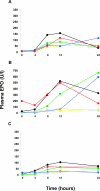Inhibition of prolyl hydroxylases increases erythropoietin production in ESRD
- PMID: 21115615
- PMCID: PMC3014028
- DOI: 10.1681/ASN.2010010116
Inhibition of prolyl hydroxylases increases erythropoietin production in ESRD
Abstract
The reasons for inadequate production of erythropoietin (EPO) in patients with ESRD are poorly understood. A better understanding of EPO regulation, namely oxygen-dependent hydroxylation of the hypoxia-inducible transcription factor (HIF), may enable targeted pharmacological intervention. Here, we tested the ability of fibrotic kidneys and extrarenal tissues to produce EPO. In this phase 1 study, we used an orally active prolyl-hydroxylase inhibitor, FG-2216, to stabilize HIF independent of oxygen availability in 12 hemodialysis (HD) patients, six of whom were anephric, and in six healthy volunteers. FG-2216 increased plasma EPO levels 30.8-fold in HD patients with kidneys, 14.5-fold in anephric HD patients, and 12.7-fold in healthy volunteers. These data demonstrate that pharmacologic manipulation of the HIF system can stimulate endogenous EPO production. Furthermore, the data indicate that deranged oxygen sensing--not a loss of EPO production capacity--causes renal anemia.
Figures

References
-
- Jelkmann W: Erythropoietin: Structure, control of production, and function. Physiol Rev 72: 449–489, 1992 - PubMed
-
- Bachmann S, Le HM, Eckardt KU: Co-localization of erythropoietin mRNA and ecto-5′-nucleotidase immunoreactivity in peritubular cells of rat renal cortex indicates that fibroblasts produce erythropoietin. J Histochem Cytochem 41: 335–341, 1993 - PubMed
-
- Maxwell PH, Osmond MK, Pugh CW, Heryet A, Nicholls LG, Tan CC, Doe BG, Ferguson DJ, Johnson MH, Ratcliffe PJ: Identification of the renal erythropoietin-producing cells using transgenic mice. Kidney Int 44: 1149–1162, 1993 - PubMed
-
- Hirota K, Semenza GL: Regulation of hypoxia-inducible factor 1 by prolyl and asparaginyl hydroxylases. Biochem Biophys Res Commun 338: 610–616, 2005 - PubMed
-
- Schofield CJ, Ratcliffe PJ: Oxygen sensing by HIF hydroxylases. Nat Rev Mol Cell Biol 5: 343–354, 2004 - PubMed
Publication types
MeSH terms
Substances
LinkOut - more resources
Full Text Sources
Other Literature Sources
Medical
Research Materials

